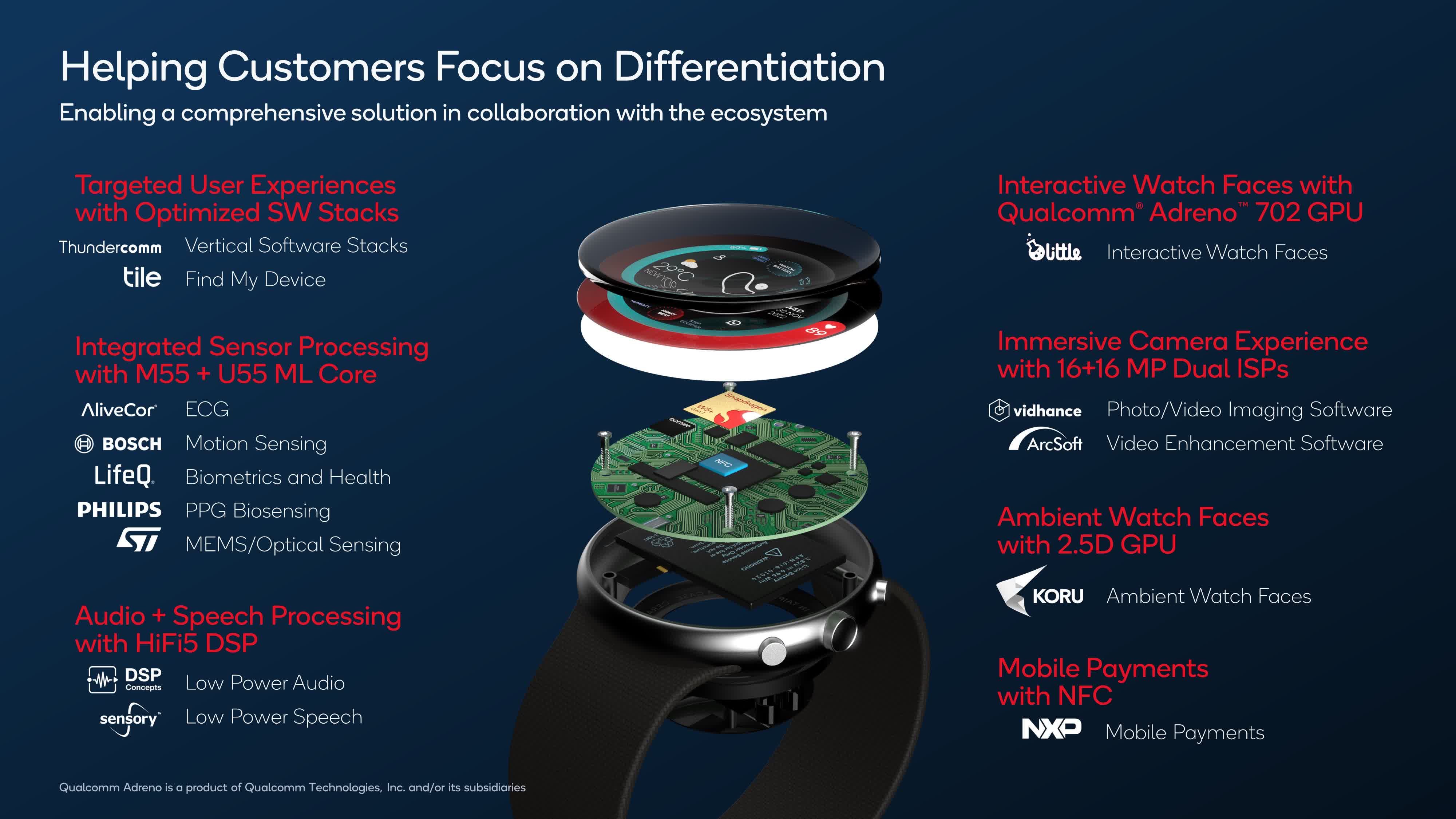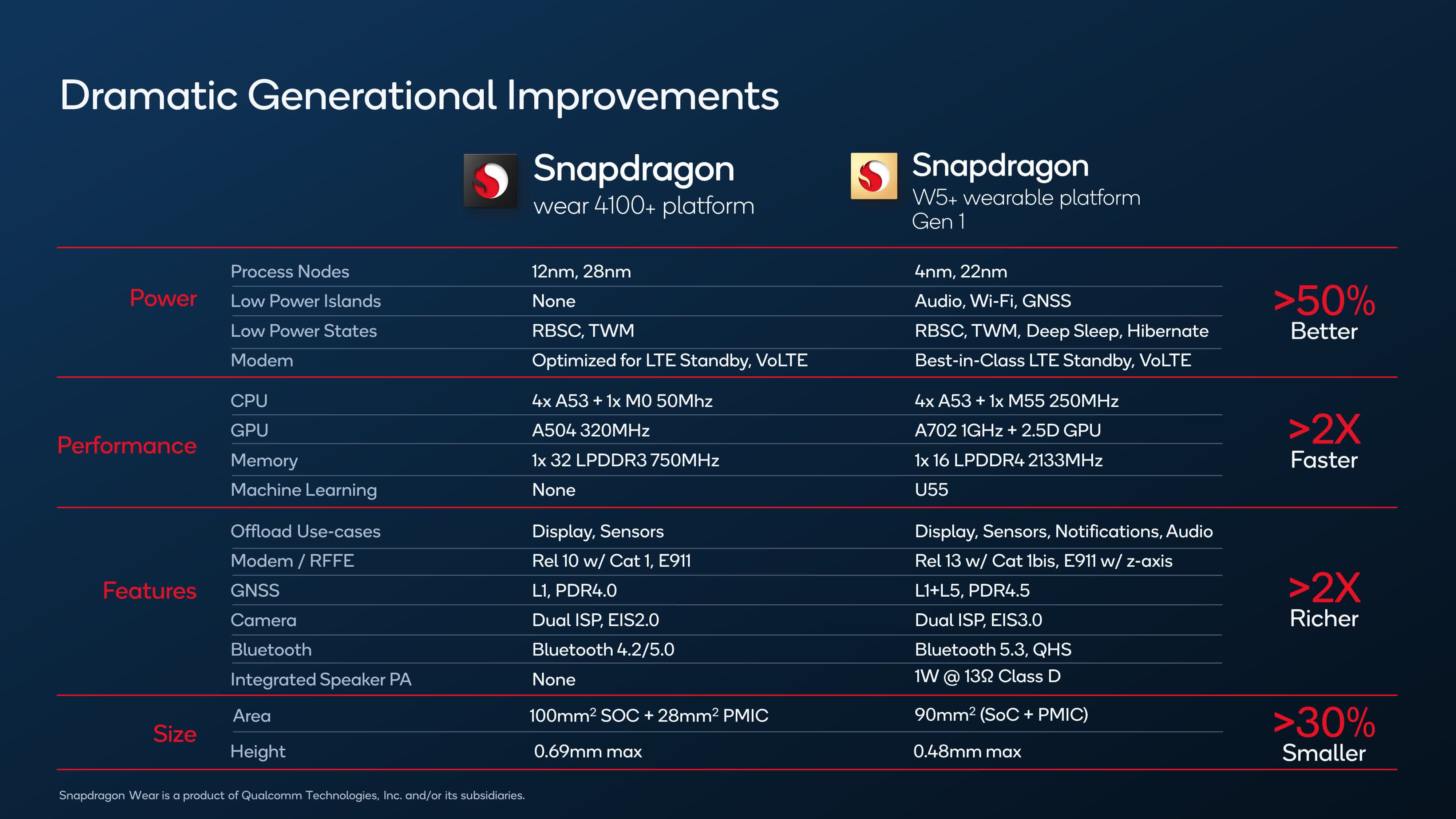In context: In the early days of the wearables market, devices like smartwatches used components that were primarily designed for smartphones. From a practical perspective, this made complete sense. Huge amounts of time and money had been invested in smartphone-related technologies, and with the appropriate adaptations, chips based on these technologies proved to be a good fit for the nascent wearables industry. However, there's nothing that can replace purpose-built designs, and that's what Qualcomm is doing with its new Snapdragon W5 platforms.
In the tech business, sometimes it takes a few generations to really get things right. That's particularly true in the semiconductor industry, where multi-year development cycles often mean that parts originally intended for one purpose or device get used in a different application.
After going through several iterations of silicon designs for wearables over the last few years, Qualcomm's new Snapdragon W5+ and W5 Gen 1 platforms use fewer phone-based elements and more dedicated wearable-driven technologies.
As the smartwatch market has matured, it's become clear that multi-day battery life, always on displays, and more advanced interaction models have become important expectations from potential purchasers. In order to achieve this, you need a chip with an architecture that draws less power and is smarter about how it consumes the battery power that it has access to. Oh, and a smaller size wouldn't hurt either.
Qualcomm is taking an important step towards several of those vectors by moving to a smaller, more power efficient 4 nm design. The new architecture moves the capability to do multiple critical functions, including screen-based notifications and audio playback, away from the main processor to the always-on, ultra-low power co-processor. That means smartwatches based on this hybrid design can function the vast majority of the time without turning on the main processor at all – a huge step forward in power efficiency and improved battery life.
In addition to these changes, Qualcomm has implemented what it calls low power "islands," which are groups of sub-components that work together to complete certain tasks, such as WiFi, GPS, and audio playback, as well as several low power states such as Deep Sleep and Hibernate, which are done in conjunction with a newly designed power management IC. Collectively, these translate to an average of 50% less power consumption versus the previous generation 4100 series chips.
In real-world terms, slim smartwatches with a 300 mAh battery can jump from 28 to 43 hours of battery life, and a 4G connected sportswatch with a 600 mAh battery goes from 48 to 72 hours of battery life.
Both the main SoC (SW5100), and the co-processor (dubbed the QCC5100) in the W5+ are Arm-based cores. The W5 is simply the SW5100 sold without the co-processor. The SW5100 features four A53 CPU cores running at 1.7 GHz, two Adreno 702 GPU cores clocked at 1 GHz, two ISPs, as well as WiFi, GNSS, and an optional 4G modem among other components. The QCC5100 co-processor is based on a Cortex M55 CPU running at 250 MHz, and incorporates a display driver, separate GPU, Bluetooth 5.3 radio, and more.
From a performance perspective, the combination of these two chips translates into a 2x improvement according to Qualcomm, along with the 50% reduction in power. Thanks to the move to more advanced manufacturing nodes, the chips and boards that hold them are smaller, allowing for up to 30% slimmer designs (4 nm vs. 12 nm in the last design for the main SoC, and 22 nm for the co-processor vs. 28 nm in the previous one).
The more powerful main processor also enables new types of interactions with smartwatches, including 2-way video calling, 3D watch faces, real-time image recognition, smart device control and more. With the W5+, the co-processor also integrates always-on sensing and an Arm-based U55 machine learning core for health and fitness applications.
From a software perspective, Qualcomm is continuing to partner with Google's Wear OS for mainstream designs and with Android AOSP for lower-cost and specialized designs for kids, enterprise, etc. Qualcomm worked with several different companies to optimize different application capabilities such as Tile for Find My Device, NXP for mobile payments, Sensory for low-power speech recognition, and more.
The first Snapdragon W5+ powered Wear OS product is coming from Mobvoi this fall, and Oppo is debuting the first W5 with AOSP-driven smartwatch called the Oppo Watch 3 next month.
All told, it looks to be a step forward for the wearables market and the smartwatch category. By enabling more advanced interactions and longer battery life, the Snapdragon W5 platform can help to overcome the objections that some smartwatch holdouts have had about the category, while also inspiring the device's enthusiasts to consider new options.
Bob O'Donnell is the founder and chief analyst of TECHnalysis Research, LLC a technology consulting firm that provides strategic consulting and market research services to the technology industry and professional financial community. You can follow him on Twitter @bobodtech.


